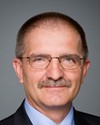Yes. I've handed out copies to everyone. I'm going to flip through it rather quickly, in light of the time constraints.
I did want to start by first off acknowledging a lot of Ramsey's comments. It may surprise some of you, but I'm going to support a lot of the comments he's made today. I think we're in agreement on a broad range of issues.
I'll set out a bit more context for you. First, we are the national organization representing the producing side of the mining business. Those who have mines in production or almost in production make up our membership. We currently have about 36 full members and a bunch of associate members that represent the supply side of the business.
The industry, as I'm sure all of you know, is a fairly large part of the Canadian economy, and it has been for quite some time. With the run-up in commodity prices that we've seen over the past five or six years, with a dip in 2008 that turned out to be quite short term for our sector, there is a large degree of optimism in our industry that we're in for a cycle of growth we haven't seen in generations. For example, we do an annual tax study, and we found that in 2010 there was a 65% increase in payments to governments that year. That doesn't happen every year, but what it does underscore is how quickly the mining industry turned around from the 2008 economic crisis.
If there is a key message for you, it's that ours is a very important engine of growth right now in a time of global economic uncertainty.
We are the largest private sector employer of aboriginal Canadians across the country. To Ramsey's point, there are certainly areas where there has been more success than others. I think every new project tends to bring with it strong commitments to aboriginal employment and business procurement, and we're seeing increasing trends in that area.
You'll find that our industry right across the country has a broad range of commodities. Most of what the world needs can be found in different parts of Canada.
There's a quick slide here where I report back what you have said about the industry in terms of our environmental performance. Ours is an industry that has a significant, albeit local, impact on the environment. We have made major strides in the last few decades in trying to better manage those impacts. The job is not done. There is ongoing work and improvements that can continue to be made with respect to environmental management.
In addition to the commitments we make with respect to meeting regulatory obligations, we have a program called Towards Sustainable Mining. This program is a condition of membership, which includes member companies reporting on site performance at the facility level, and that is subject to external verification of performance every three years. It's an initiative that has won MAC awards, and it has been recognized as best in class across the country. It is a demonstration of our industry's commitment to continuous improvement and to earning our social licence.
To put what's happening globally into context a little more, the China factor, which we are all aware of—it's primarily China at this point, but Brazil, India, Mexico, and other countries are having an impact on the global economy, particularly with the demand for commodities.... We've seen 30 consecutive years of 8% to 15% growth. While China's impact in the 1980s was minimal, today it is huge. They consume 30% of the world's commodities today.
We've seen major run-ups in commodity prices. This table shows results from June 2011. There has been a bit of a dip since then, but prices have remained pretty robust. Copper was most recently at $360 per pound. That would have been beyond our wildest dreams a decade ago.
In this context, there is a race around the world for developing and finding new projects, and Canada is well positioned to benefit from that. Obviously we want to do so responsibly, but at the moment, for example, we are attracting the largest share of global exploration spending. We've estimated some $137 billion in potential new investment in Canada over the next five to ten years in different projects or in project expansions across the country.
We expect that to continue. Why? Because in the U.S., 76 out of every 100 persons has a car or a computer; in China, it's 10 and 4, respectively. As their middle class grows and starts to want the things that we have, the demand for commodities will continue.
In terms of opportunities across the country, there are a lot in every region. We've highlighted for you those projects that are in advanced stages in the territories, with significant capital expenditures there. The impact we've had in the north over the last decade, particularly in the Northwest Territories around the diamond industry, has been significant. We represent 30% of GDP in the Northwest Territories. We are the largest employer of aboriginal people. There has been some $4 billion in business procurement with aboriginal businesses in the Northwest Territories. So we have had a significant and potentially transformative impact.
This is not how the industry used to do business in the north. The experiences with Giant are very different from the way they are today with the diamond mines and with the way I think we will see Meadowbank unfold.
To turn to some of the issues that Ramsey raised, and where I think there is also some broad agreement about the challenges facing the north, we too recognize that aboriginal training and employment are challenges. We are very committed to and have been very big supporters of the aboriginal skills and employment partnership program with the federal government. The mining sector has been the biggest user of this program, and it has helped to provide training and on-the-job work experience for aboriginal people in Canadian mines. The most successful of these has been based in Yellowknife, but there are other initiatives like that across the country.
We also agree that there is definitely a need for infrastructure going forward. Investments in roads and ports in order to facilitate the kinds of investments we are talking about will be important.
We too believe in a strong and robust environmental assessment process. We want it to be efficient, but we do not argue in any way for a lessening of the quality of environmental review. The amendments to the CEAA are a case in point, and we'll be presenting our views to the environment committee shortly, in the next couple of weeks. But in our view, what those amendments did was put the Canadian Environmental Assessment Agency in charge of environmental assessment. They have made harmonization with the provinces possible and they have shortened the front-end delay, which was really associated with just getting the federal government to agree to start the process. With those amendments, the feds now start immediately. It has not in any way, in our view, compromised the quality of environmental assessment, but it has made it more efficient and has allowed for a better use of resources devoted to environmental assessment.
We share the views that Ramsey expressed on the potential cuts to this program. There haven't actually been cuts yet. There have been rumours of potential cuts. We've been advocating that funding be renewed in the upcoming budget, not only because of the demand coming from our sector in particular but also in general to implement effective and efficient environmental assessment.
There are a number of issues unique to the north as well. We've been very involved with the various boards and agencies in the Northwest Territories and in Nunavut. We've been strong proponents of advancing Nunavut legislation and are very supportive of the progress made there.
We think there is tremendous opportunity in northern Canada. There is, at this point, just one operating mine in Nunavut. There is potential for more. I don't foresee a huge number coming in rapid succession, but I think Nunavut itself would welcome some additional mining projects to help support its economy. So we look forward to the years to come and the possibilities in northern Canada.
I'll stop there, because I'm sure there will be lots of opportunity to expand on these topics through questions.









